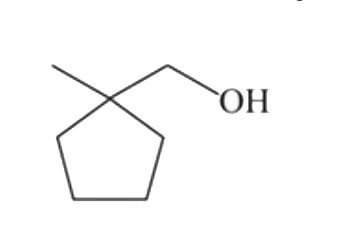H3BO3(s)+aq.NaOHΔ−−→(X),
H3BO3(s)+moltenNaOHΔ−−→(Y)
Compound (X) & (Y) are respectively,
Na3BO3,Na3B
Na3BO3,NaBO2
Na[B(OH)4],Na3BO3
Na3BO3,Na[B(OH)4
The correct Answer is:C
To solve the question, we need to analyze the two reactions involving boric acid (H₃BO₃) and sodium hydroxide (NaOH) under different conditions.
1. Identify the first reaction:
- The first reaction involves solid boric acid (H₃BO₃) reacting with aqueous sodium hydroxide (NaOH) when heated.
- The balanced equation for this reaction is:
H₃BO₃(s)+aq.NaOHΔ→NaBO₂H₄
- Here, the product formed is sodium tetrahydroborate (NaBO₂H₄).
2. Identify the second reaction:
- The second reaction involves solid boric acid (H₃BO₃) reacting with molten sodium hydroxide (NaOH) when heated.
- The balanced equation for this reaction is:
H₃BO₃(s)+molten NaOHΔ→Na₃BO₃+3H₂O
- Here, the product formed is sodium borate (Na₃BO₃) along with water (H₂O).
3. Determine the compounds (X) and (Y):
- From the first reaction, we found that the product (X) is sodium tetrahydroborate (NaBO₂H₄).
- From the second reaction, we found that the product (Y) is sodium borate (Na₃BO₃).
4. Final Answer:
- Therefore, the compounds (X) and (Y) are:
- (X) = NaBO₂H₄
- (Y) = Na₃BO₃
Conclusion:
The correct answer for the compounds (X) and (Y) is:
- X = NaBO₂H₄
- Y = Na₃BO₃
- The first reaction involves solid boric acid (H₃BO₃) reacting with aqueous sodium hydroxide (NaOH) when heated.
- The balanced equation for this reaction is:
H₃BO₃(s)+aq.NaOHΔ→NaBO₂H₄
- Here, the product formed is sodium tetrahydroborate (NaBO₂H₄).
- The second reaction involves solid boric acid (H₃BO₃) reacting with molten sodium hydroxide (NaOH) when heated.
- The balanced equation for this reaction is:
H₃BO₃(s)+molten NaOHΔ→Na₃BO₃+3H₂O
- Here, the product formed is sodium borate (Na₃BO₃) along with water (H₂O).
- From the first reaction, we found that the product (X) is sodium tetrahydroborate (NaBO₂H₄).
- From the second reaction, we found that the product (Y) is sodium borate (Na₃BO₃).
- Therefore, the compounds (X) and (Y) are:
- (X) = NaBO₂H₄
- (Y) = Na₃BO₃
The correct answer for the compounds (X) and (Y) is:
- X = NaBO₂H₄
- Y = Na₃BO₃
Topper's Solved these Questions
- BOOK - RESONANCE ENGLISHCHAPTER - P-BLOCK ELEMENT (BORON AND CARBON FAMILY)EXERCISE - Exercise-2 Part-II : SINGLE AND DOUBLE VALUE INTEGER TYPE23videos
P-BLOCK ELEMENT (BORON AND CARBON FAMILY)
- BOOK - RESONANCE ENGLISHCHAPTER - P-BLOCK ELEMENT (BORON AND CARBON FAMILY)EXERCISE - Exercise-2 Part-III : ONE OR MORE THAN ONE OPTIONS CORRECT TYPE26videos
P-BLOCK ELEMENT (BORON AND CARBON FAMILY)
- BOOK - RESONANCE ENGLISHCHAPTER - P-BLOCK ELEMENT (BORON AND CARBON FAMILY)EXERCISE - Exercise-1 Part-II : ONLY ONE OPTION CORRECT TYPE Section (G) : Halides, Alums & Other metal salts15videos
P-BLOCK ELEMENT (BORON AND CARBON FAMILY)
- BOOK - RESONANCE ENGLISHCHAPTER - P BLOCK ELEMENTSEXERCISE - PART -II23videos
P BLOCK ELEMENTS
- BOOK - RESONANCE ENGLISHCHAPTER - P-BLOCK ELEMENTS (HALOGEN & NOBLE GASES)EXERCISE - APSP PART-322videos
P-BLOCK ELEMENTS (HALOGEN & NOBLE GASES)
Similar Questions
H3BO3 is :
View SolutionH3BO3 is.
View Solution(P)Δ−−→(Q)+(R)↑⏐⏐+(S)↑⏐⏐
(X)Δ−−→(Y)+(R)↑⏐⏐+(S)↑⏐⏐
P and X are respectivelyView SolutionBoric acid H3BO3 is a:
View SolutionBariumadipateDrydistillation−−−−−−−−→(A)MeCO3H−−−−−→(B)
The compounds (A) and (B), respectively, are:View SolutionBorax is converted into crystalline boron by the following steps :
Borexx−−→H2BO3Δ−−→B2O3Y−−→ΔB
X and Y are respectively :View SolutionIn the reaction sequence
C6H5CHONH2OH/H⊕−−−−−−−−→Δ(X)P2O5/Δ−−−−−→(Y)H2O,H+−−−−−→(Z)
(X), (Y) and (Z) respectively beView SolutionConsider the following sequence of reactions
 H+/Δ−−−−→(X)1.03−−−−−−−−−−→2.Zn/CH3COOH(Y)NaOH−−−→Δ
H+/Δ−−−−→(X)1.03−−−−−−−−−−→2.Zn/CH3COOH(Y)NaOH−−−→Δ 
The intermediate products (X) and (Y) are respectivelyView SolutionFind the number of reaction from the given reaction which can show calcination process :
(i) CaCO3.MgCO3Δ−−→CaO+MgO+2CO2
(ii) CuCO3.Cu(OH)2Δ−−→2CuO+H2O+CO2
(iii) Al2O3.2H2OΔ−−→Al2O3+2H2O
(iv) 2Cu2S+3O2Δ−−→2Cu2O+2SO2.View SolutionMatch the Following :
Column I Column II(A) Borax Δ−−→.(p) Inorganic benzene(B) Borax +NH4ClΔ−−→(q) NaBO2+B2O3(C) Borax +NH3Δ−−→(r) (BN)x(D) Borax +H2O→(s) H3BO3View Solution

